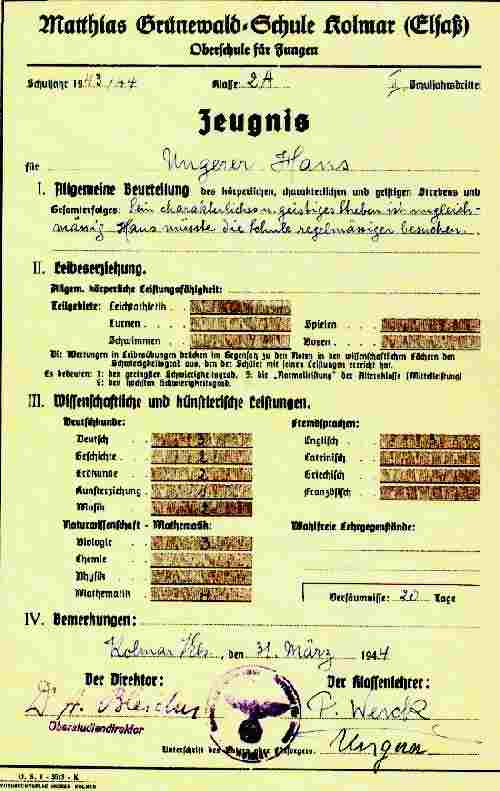
Figure 1.--German report cards during the NAZI era showed the importance given to sports and phyical education. This is from a fascinating bool by Tomi Ungerer, "Tomi: A Childdhood Under the NAZIs." |

|
Hitler had a strong belief in the importance of physical education for German youth. He wrote, "A man of little scientific education but physically healthy, with a good, firm character, imbued with the joy of determination and will-power, is more valuable for the national community than a clever weakling." Physical education in th NAZI view was perhaps the most important parts of the German school child's day. Hitler increased the time for physical training to 2 hours per day, rather than the customary 2 hours per week before the NAZI take over. Physical conditioning was a major focus of the Hitler Youth movement. Competition in phyical conditioning was stronly promoted.
Hitler had a strong belief in the importance of physical education for German youth. He wrote, "A man of little scientific education but physically healthy, with a good, firm character, imbued with the joy of determination and will-power, is more valuable for the national community than a clever weakling." [Adolf Hitler, Mein Kampf.] Hitler says, "My system of education is a harsh one. Weakness must be stamped out. The world will shrink in trepidation from the youngsters, who grow up in my Ordensburgen. A violent, masterful, dauntless, cruel younger generation-that is my aim. There must be nothing weak and tender about it. Its eyes must glow once more with the freedom and splendour of the beast of prey." [Blackburn, p. 6.]
P hysical education in th NAZI view was perhaps the most important parts of the German school child's day. Hitler increased the time for physical training to 2 hours per day, rather than the customary 2 hours per week before the NAZI take over. [Koch, p. 163.] Report cards gave prominance to sports and physical education.
The PE program included athletics, gymnastics, swimming, playing, and boxing. [Ungerer, p. 87] Boxing was reportedly of special importance and was compulsory for boys, unless there was a medical excuse. One can easily see how boxing classes could be used to torment Jewish students by ardent NAZI teachers and students before the Jewish students were expelled in 1935.
Grades on PE were not only prominently displayed on a child's report card, but there were also fitness tests. Children who did poorly might be teased and hmiliated by the other boys. Some children in secondary schools were even expelled for failing these tests. This was especially true of te NAPOLA and Adolf Hitler Schools where standards were especially rigorous.
Physical conditioning was a major focus of the Hitler Youth movement. Children were encouraged, very often pressured to join the Hitler Youth. Finally membership was made compulsory. The Hitler Youth was the embodiment of the German national unity and NAZI ideology. The Hitler Youth "wanted to impregnate the school system with its own brand of egalitarianism". [Stachura, p. 146.] Children were taken out of the school to perform their exercises for the day, only to return too tired to concentrate on their studies.
The Hitler Youth progrm changed over time, especially after World War II began. The War changed the Hitler Youth into a movement that concentrated on tasks that would ready the youth for the war they would soon enter. [Stachura, p. 159.] Now instead
of marching and playing sports, children would do things such as "gather in the harvest, plant crops, collect old materials such as iron, paper, wood, and clothing..." [Stachura, p. 159.] "Every job must be directed towards the necessities of war. Each duty that we fulfill serves victory!" a youth leader remarks. [Stachura, p. 159.] Every boy was trained for the war through their physical education. War was the highest form of struggle; the greatest form. [Blackburn, p. 69.] "A war was to be desired at least every 25
years". [Blackburn, p. 69.]
Competition in phyical conditioning was stronly promoted. Competition was seen as the most desired state that a youth could hope to partake in. Consider this story in a book: Werner is a young lad who "enjoys gymnastics because he is so good at it...Once he was first in his row...". [Blackburn, p. 71.] The story goes on to say that Werner was daydreaming one day and did not do well in a rowing competition, but that he competed well the next time and won. [Blackburn, p. 71.] This emphasizes the need for pride in physical achievements. Physical competition was the best way to practice for the war that was to come.
Kodi and Crystal as part of an exchange agreement provide us access to their research.
Blackburn, Gilmer W. Education in the Third Reich: Race and History in Nazi Textbooks. State University of New
York Press: Albany 1985.
Koch, H. W. The Hitler Youth: Origins and Development 1922-1945. Stein and Day: New York, 1975.
Stachura, Peter D. The German Youth Movement 1900-1945. St. Martin's Press: New York 1981.
Ungerer, Tomi. Tomi: A Childdhood Under the NAZIs. (Boulder: Robert Reinhart Publishing Group, 1998).
Related Chronolgy Pages in the Boys' Historical Web Site
[Main Chronology Page]
[The 1910s]
[The 1920s]
[The 1930s]
[The 1940s]
Navigate the German school pages
[Main NAZI curriculum page]
[Main school uniform national page]
[Main German school uniform page]
[Imperial Germany]
[Weimar Republic]
[NAZI era]
[Post-war Years]
[Modern Germany]
Navigate the Relate Boys Historical Clothing Style Pages
[Main country page]
[Long pants suits]
[Short pants suits]
[Lederhosen]
[Kneesocks]
[Eton suits]
[Jacket and trousers]
[Blazer
[School sandals]
Navigate the Boys' Historical Clothing School Uniform Pages
[Main School Uniform Page]
[Australia]
[England]
[France]
[Germany]
[Italy]
[Japan] [New Zealand]
[Scotland]
[United States]
Navigate the HBC School Section:
[About Us]
[Activities]
[Chronology]
[Clothing styles]
[Countries]
[Debate]
[Economics]
[Garment]
[Gender]
[Hair]
[History]
[Home trends]
[Literary characters]
[School types]
[Significance]
[Transport and travel
[Uniform regulations]
[Year level]
[Other topics]
[Images]
[Links]
[Registration]
[Tools]
[Return to the Historic Boys' School Home]
